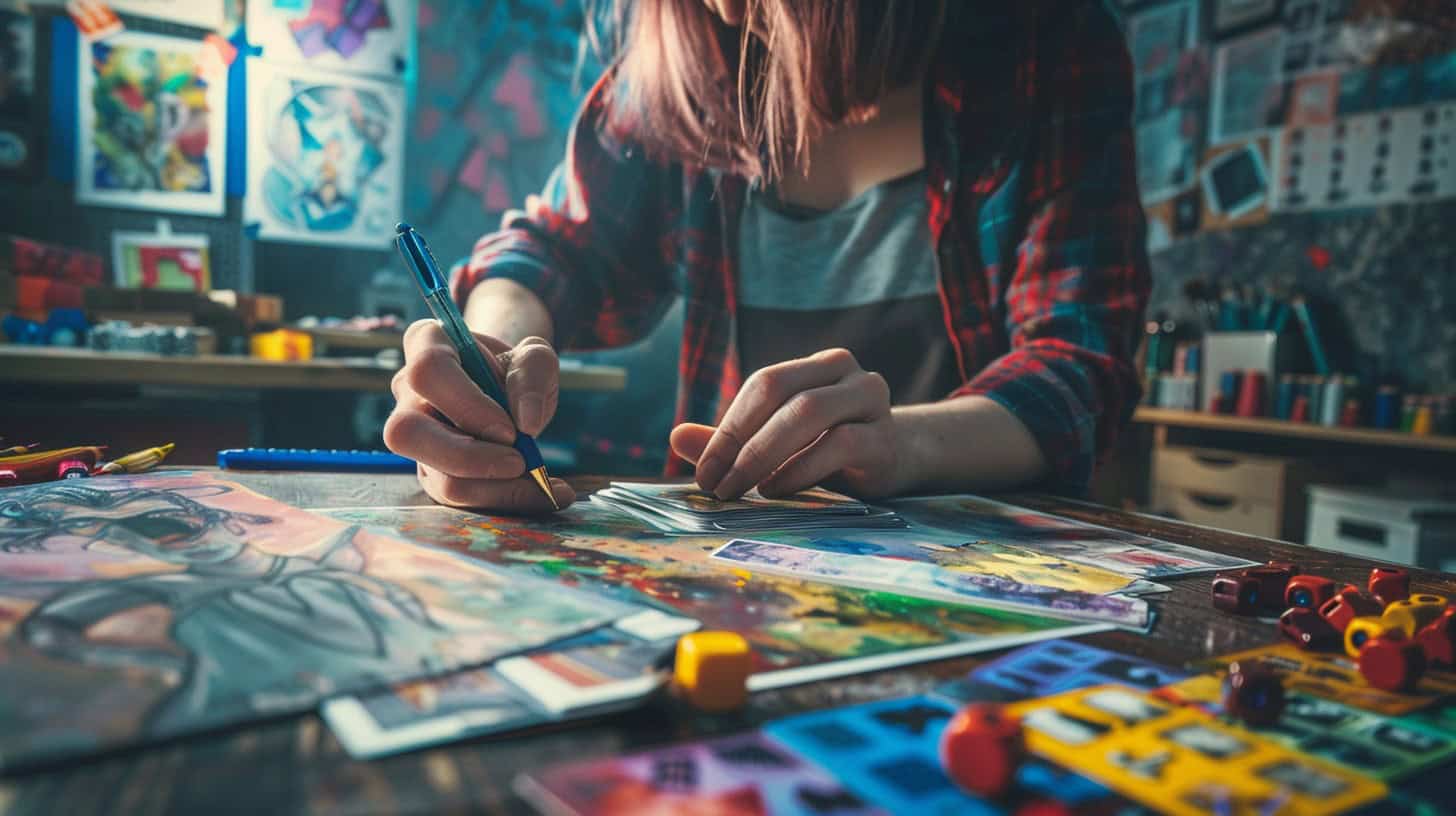Making a card game often starts with a great idea but hits roadblocks along the way. One important fact is that designing a card component is central to the process. This article will guide you through eight critical steps, from design to market success, to turn your concept into reality.
Let’s get started!
Key Takeaways
Start making a card game by setting clear goals. Decide what players will try to do in your game, like winning points or completing missions.
Design and test your cards. Sketch ideas, make prototypes, and playtest with friends to see what works well.
Use technology for designing cards and getting feedback. Tools like Adobe Illustrator help make great-looking cards that are easy to update based on player suggestions.
Pick the right manufacturer who knows about games. They should use strong paper and good ink, so your cards last long and look good.
Tell people about your game using social media, ads, and events where they can play it. This helps more folks learn about your game and want to buy it.
Table of Contents
Understanding Card Game Development Basics

Starting with a clear goal for how your game plays is key. Then, design your cards and use classic moves to make something fun and new.
Defining Gameplay Objectives
Defining gameplay objectives is the first step in creating a card game. This step decides what players try to achieve, like winning points in Teen Patti or completing quests in Legends of Runeterra.
Goals must be clear, so players understand how to win or score high.
Gameplay goals direct design choices. For instance, if the aim is strategy over luck, mechanics might favor player decisions rather than random draws. Effective objectives link closely with themes – a fishing game might have objectives about catching certain types of fish.
Objectives vary; some games focus on collecting sets like Magic the Gathering, while others involve completing tasks before opponents.
Gameplay objectives are not just rules but the soul of your game.
Crafting Your Card Game Design
Crafting a card game starts with a strong design. I focused on creating mechanics inspired by games like UNO and poker, but wanted something new. So, I aimed to innovate the traditional gameplay we see in those classics.
My process included sketching out ideas, setting clear rules, and deciding how players win or lose. For my own project, drawing inspiration from Teen Patti was key—I even thought about ways players could try Teen Patti for real cash online as part of my game’s unique hook.
The next step involved making prototypes; each one added more detail than the last. The first prototype used simple materials—an old box and plastic sleeves for cards with basic artwork drawn on them.
By the second prototype, colors popped more and information became clearer on each card. This hands-on approach helped me see what worked and what didn’t early on.
Now let’s talk about moving these designs off paper…
Leveraging Classic Game Mechanics
Using old game mechanics makes your card game easy to learn but still fun. Think about how trading card games mix strategy and luck. We did this by adding special abilities to cards that players already know, like fishing games or story-based adventures.
This means players get comfortable fast, but always find something new.
For our game, we tested a lot with friends and made big changes based on what they said. This helped us see which classic parts people loved and where we could do something no one has seen before.
Next up, let’s talk about making your own unique game from scratch.
Crafting Your Own Card Game from the Ground Up
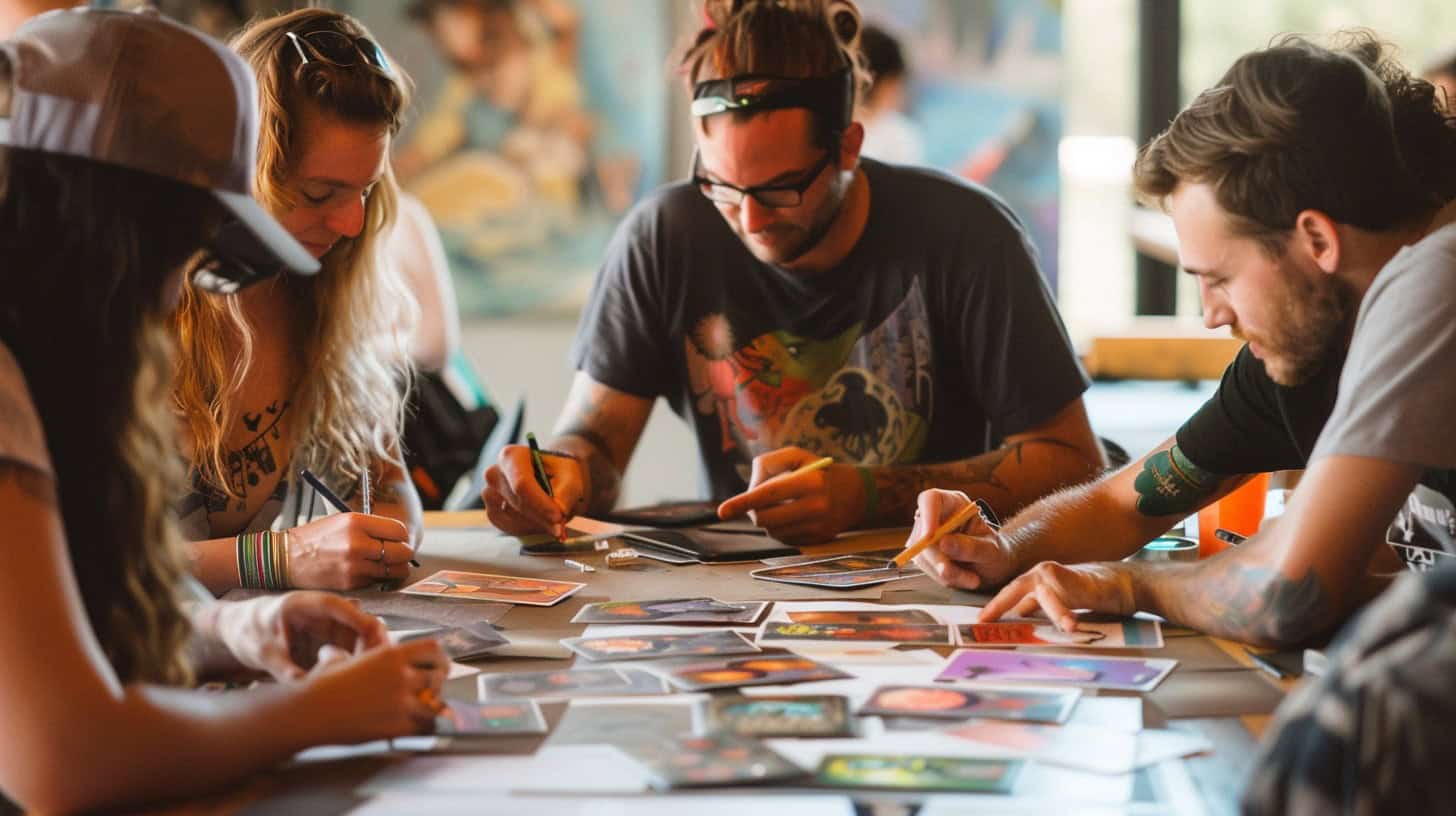
Making your own card game? Start with fresh ideas for how the game works. Then, sketch and test your design to make sure it’s fun.
Innovating Game Mechanics
To change card game rules in new ways, creators focus on fresh ideas. They draw from a mix of old and new concepts to keep players engaged. The video for the tabletop card game “Influence” shows this process in action.
It starts with hand-drawn artwork on blank cards, moving to printed designs with plastic covers. This approach lets creators test their ideas fast and find what works best.
Playtesting is key—it turns good ideas into great games.
Creators rely heavily on playing their game many times. They see how real people like you play it, making changes along the way. This helps make sure that when the game finally reaches your table, it’s fun and keeps you coming back for more.
Drafting and Prototyping Your Design
Creating a card game starts with drafting your design. This step turns your ideas into something you can see and touch. Here’s how to do it:
- Write down your game rules. Clear and simple rules make the best games.
- Sketch initial card designs on paper. Include basic elements like suits or powers.
- Choose symbols and fonts that fit your game theme. Your choices should make cards easy to read and understand.
- Create a digital version of your card design using tools like Adobe Illustrator or Photoshop. This step makes editing easier.
- Print a basic prototype at home. Use card stock for a more authentic feel.
- Test printing with a manufacturer comes next, as suggested for refining prototypes.
- Gather feedback by playing with friends or family members. Watch for what works and what doesn’t.
This part is crucial because three-fourths of your ideas will change here.
Next, you’ll need to refine your game based on this feedback…
Playtesting and Iterating
Playtesting and iterating turn good card games into great ones. It’s a vital step for fixing issues and making sure players love the game. Here’s how to do it right, with firsthand insights.
- Gather a diverse group of players. Include folks who are new to card games and seasoned veterans. This mix offers varied feedback that covers all angles.
- Set clear goals for each test session. You might focus on game balance one time and player engagement the next.
- Use prototypes that are easy to change. Cards made from basic materials work best here, since you’ll be adjusting rules and content often.
- Collect feedback immediately after playtesting sessions. Ask specific questions about gameplay, rules clarity, and fun factor.
- Observe non-verbal cues during playtests. Players might show confusion or excitement without saying a word — important indicators of your game’s impact.
- Iterate quickly based on feedback. Make changes, big or small, then test again to see if they work as intended.
- Track versions of your game to see progress over time. Note what changes at each stage and why, keeping records in a simple spreadsheet.
I found that engaging with players directly yields actionable insights that can dramatically improve your game’s appeal and functionality.
Through this process, you’re not just testing the game, but also building a community around it — an essential step for success in today’s market.
In summary, don’t underestimate playtesting and iterating; they’re your best tools for refining your game until it shines.
Collaborating with a Card Game Designer
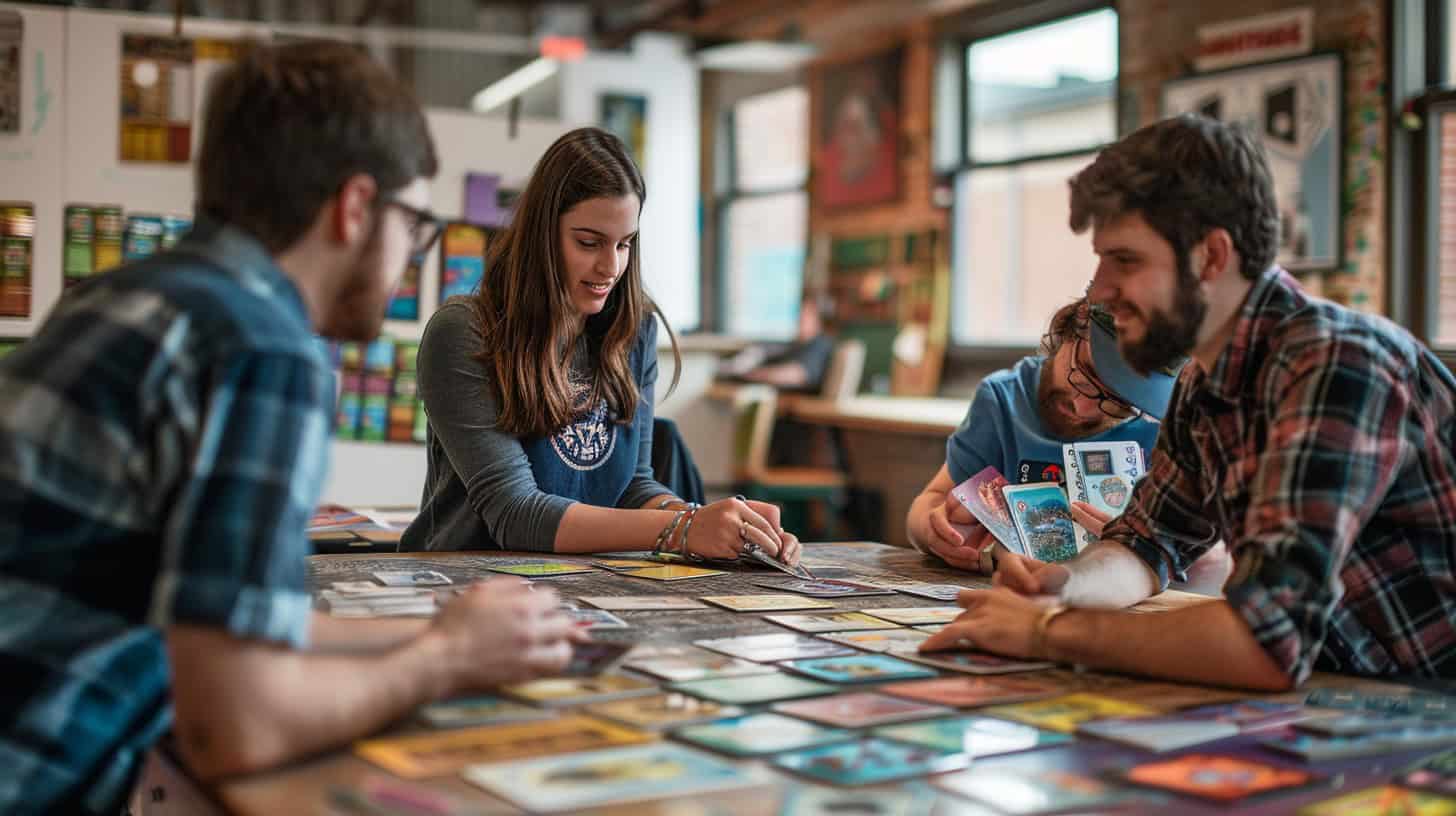
Working with a skilled artist can turn your ideas into stunning visuals for your game. They’ll use programs like Adobe Illustrator to draw amazing artwork and layouts for the cards, making them look professional and appealing.
Dive deeper to learn more!
Engaging a Professional Designer
Hiring a pro designer makes a big difference. They know how to make cards look great and play well. I learned this firsthand. My game went from okay to awesome with their help. They used tools like Adobe InDesign for layouts and vector files for clear images.
They also pick the right finishes, like gloss or matte varnish, which can change how your game feels and lasts. With their expertise, they made sure my cards had that professional touch—something hard to achieve on my own.
Plus, they knew all about printing options, whether it’s digital print-on-demand services or large runs with offset printers.
Exploring Card Design Software
After choosing to work with a professional designer, it’s time to look into card design software. This tool helps bring your card game ideas to life. The software makes it easy to change artwork and designs based on feedback.
With this technology, creating final prototypes with proper prints becomes straightforward. One key fact is that the video “Influence” showed how useful card design software can be in making tabletop games.
The creator of “Influence” suggested test printing with a manufacturer using the software. This step ensures your cards look as good in person as they do on screen. Also, subscribing for game development advice was recommended, which includes learning more about using such software effectively.
Card design tools let you visualize changes quickly and keep improving your game until it’s just right.
The final prototype featured proper prints and artwork, created with the help of card design software.
Producing Your Card Game
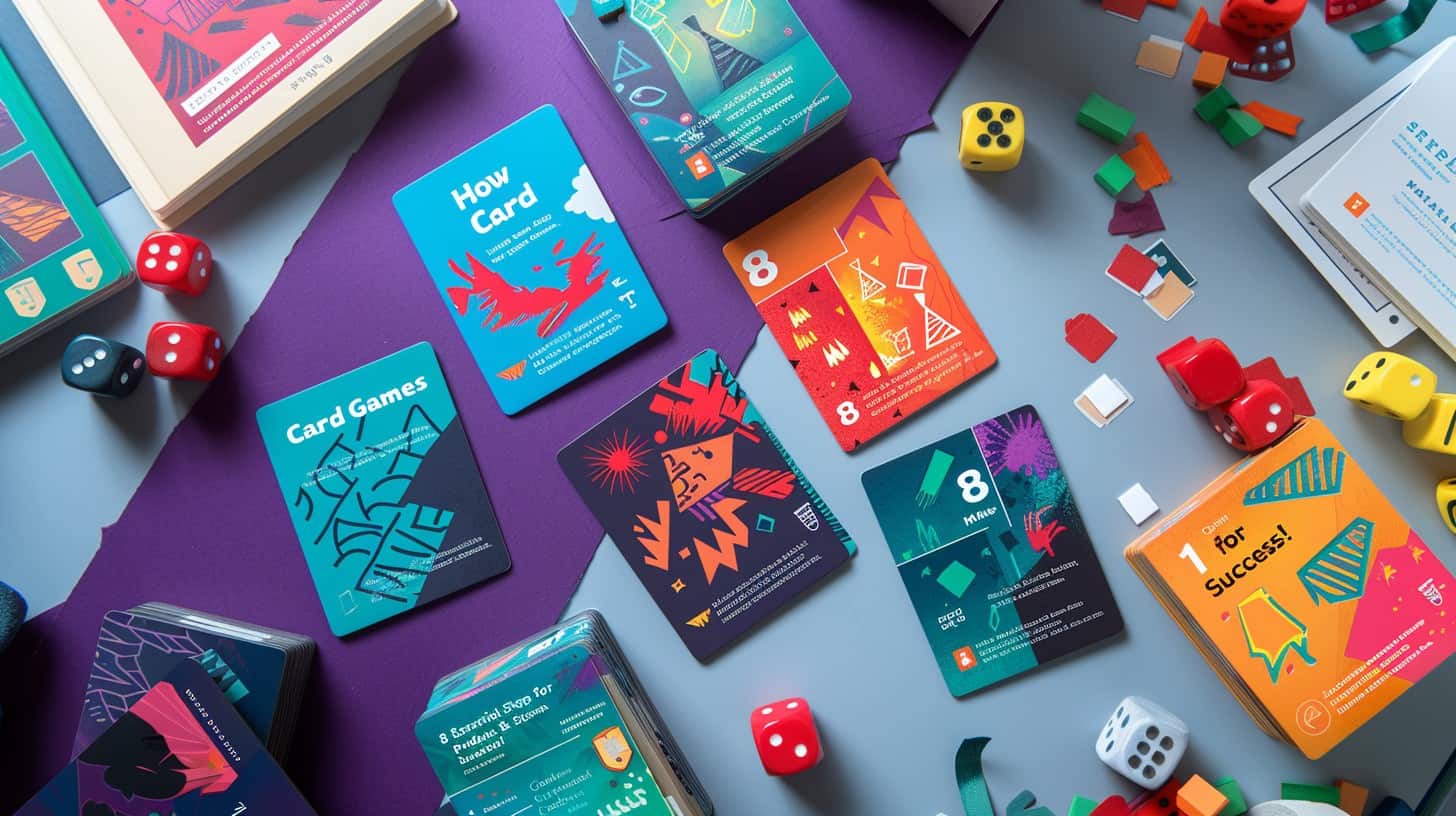
Making your card game real means picking the right factory and learning how the making process works. Ready to learn more? Keep reading!
Selecting a Game Manufacturer
Choosing the right game manufacturer is crucial. It ensures your card game looks great and lasts long. Here’s how to do it:
- Start with research. Look at reviews and ask for referrals to find top manufacturers.
- Check their products’ quality. Order samples to see if they use sturdy cardstock and clear gloss.
- Consider sustainability. Some local printers offer eco-friendly options for mass production.
- Compare prices, but remember, cheap can mean lower quality.
- Ask about timelines. Make sure they can deliver on time.
- Review their inventory capability. Can they handle your order size?
- Find out about any special features like embossing or unique box art.
- Make sure they offer on – demand printing to help manage costs.
I learned from creating my own game that asking lots of questions upfront saves time later.
Next, we’ll look into launching your card game in the market.
Navigating the Manufacturing Process
Making your card game involves a lot of steps. The manufacturing process is vital. You need to choose the right printer, understand the costs, and get your game out there.
- Select a printing company with experience in games. They know what paper feels strong and which ink lasts.
- Decide on paper stock and coating. Glossy cards look nice, but might be hard to shuffle.
- Talk about card size early. Size affects how people play and carry your game.
- Understand the cost breakdown. Printing, cutting, and boxing add up.
- Ask for samples before full print runs. See how colors and textures turn out.
- Learn about lamination options for durability.
- Plan packaging that stands out but protects the cards during shipping.
- Explore printing machines used for short runs versus large ones.
- Consider timelines for printing and delivery to meet launch dates.
From my own work, finding a reliable printer meant balancing quality with cost-effective choices without sacrificing how the final product looked or felt in players’ hands.
Negotiate prices, but remember good quality matters more than saving a few dollars at your game’s expense.
Using these steps helped me avoid common pitfalls like delays due to poor planning or choosing low-quality materials that would have disappointed players and hurt sales after all my hard work in design and testing phases was complete.
Launching Your Card Game in the Market
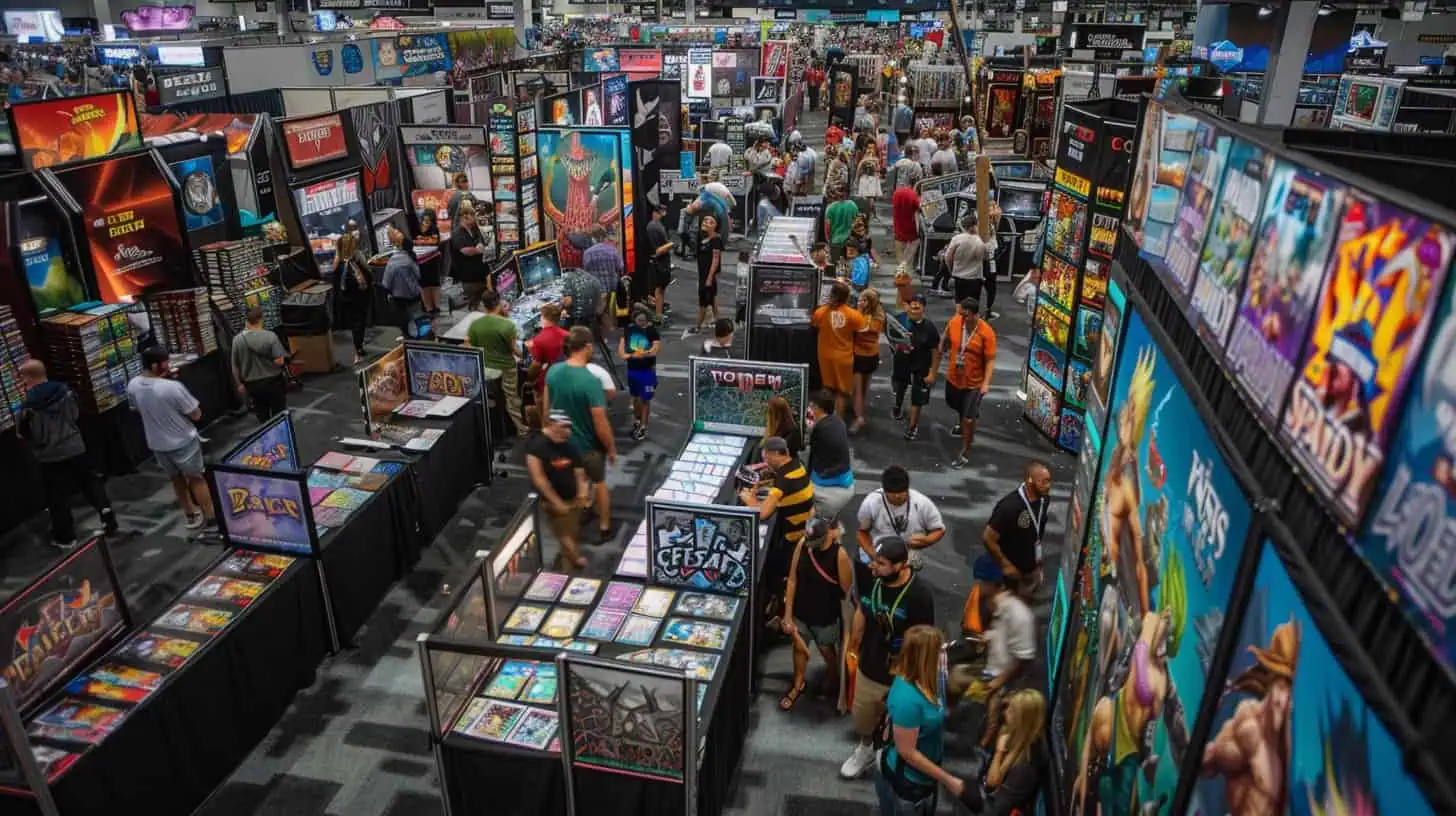
Putting your card game out there means you have to catch the eye of stores and make the most of places like Amazon.
Targeting Retail Partners
Find stores that sell games. Talk to them about your card game. Show them why it’s unique and how it fits their shop. Use clear examples, like its appeal to fans of digital collectible card games or its potential for hosting a game night.
Make sure you explain the benefits they get by selling your game, such as attracting new customers or offering something different from what they already have.
Maximizing online sales platforms is next. Find big sites like Amazon Marketplace and smaller ones too. Offer your game there to reach more people all over the world.
Maximizing Online Sales Platforms
Selling card games online needs a smart approach. Use e-commerce sites to reach many people. I found putting clear photos and detailed descriptions boosts sales. Also, offering special deals like “Buy two, get one free” attracts more buyers.
Social media is key for spreading the word about your game. Post fun videos and images of people playing your game to grab attention. Engage with your followers by answering their questions fast.
This way, you build a community that loves your game and talks about it online.
Partnering with a Logistics Provider

Choosing the right logistics partner is key—they help with storing and sending your card games. They work from big buildings where they keep lots of products before shipping them out.
Find someone you can trust to make sure your games reach players all over. Keep reading to learn how this step brings your card game closer to fans everywhere.
Evaluating Third-Party Logistics
Evaluating third-party logistics means finding the best company to handle your card game’s shipping and warehousing. This step is vital for getting your game to buyers fast and safely.
- List your needs. Think about storage, packing, and delivery speed.
- Search for companies with experience in card games or similar products.
- Check their technology. They should track shipments and manage stock well.
- Ask about costs. Look for clear pricing on storage, handling, and shipping.
- Read reviews from other businesses they’ve worked with.
- Visit their warehouse if you can. See how they work and if they’re organized.
- Talk about returns. How they deal with returned items matters.
- Test customer service. Send them a question and see how fast they answer.
Find a partner who understands what your card game needs to succeed in stores and online.
Choosing a Dependable Partner
Picking the right ally for card game creation is a game-changer. Playtesting and understanding player preferences are key steps. Let’s dive into how to find that perfect teammate:
- Look at past games they’ve helped make. Success stories tell you they can handle the job.
- Ask how they update game designs and mechanics. You want someone who thinks fresh and improves constantly.
- Check if they’re good with deadlines. A reliable partner keeps time promises without fail.
- See if they use tools like top-down design or bottom-up design wisely. Their approach should match your vision.
- Communication skills matter a lot. They must talk clearly and understand your ideas well.
- Writing rules is crucial, so find out if they do it clearly and simply.
From my experience, working with someone who gets excited about your project makes a big difference. They should share your passion.
Lastly, always ask for a sample of their work – like a prototype or design visualizations – to see their quality up close.
Choosing wisely means less stress later on, and more fun creating your dream card game together!
Strategies for Card Game Publishing
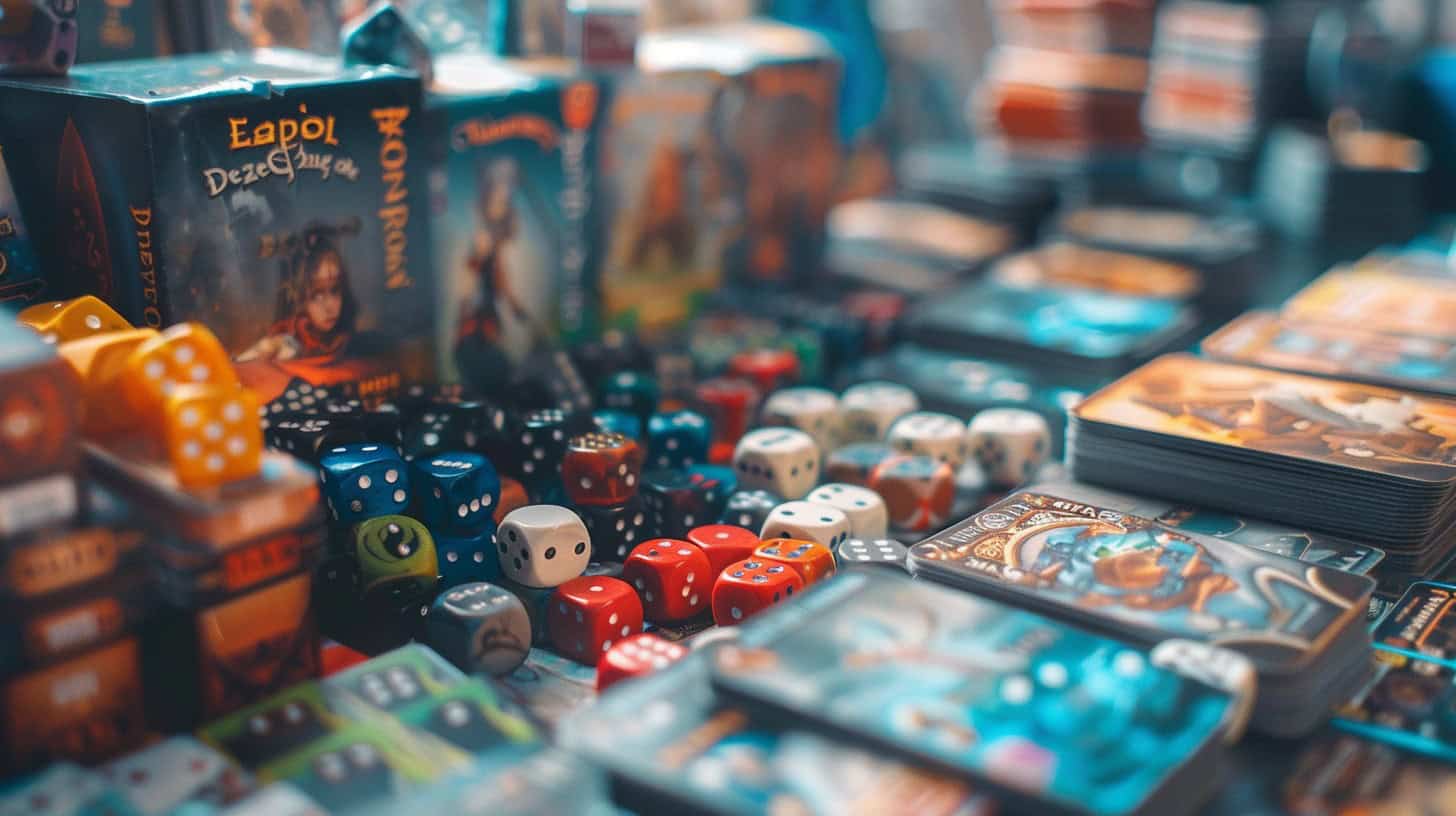
For card game publishing, mastering the process and figuring out how to market your game are key. Find ways to tell people about your great game. Use websites, social media, and ads to grab their attention.
Learn what works best for spreading the word and getting folks excited about playing your game. Now’s the time—dive in and make it happen!
Mastering the Publishing Process
To master the publishing process, you need a clear plan. Start by choosing the right way to share your card game with the world. Options include big stores or selling online through websites like Kickstarter.
Both ways have their own steps and rules.
From my own journey, I learned that making a good impression matters. This means creating eye-catching packaging and clear instructions. You also have to set prices that make sense — not too high, but enough to cover costs and make some profit.
Marketing is key too; use social media, game nights, and conventions to spread the word about your game.
Choosing a reliable printer can save lots of trouble later on. Look for one with experience in games; they should know what terms like “lithography” and “debossing” mean without needing it explained.
Lastly, think about how you’ll get your game into players’ hands. Working with logistics experts helps manage shipping from warehouses directly to customers’ doors or stores efficiently — this is where understanding drop-shipping can be useful.
Developing Effective Marketing and Promotion
After mastering the publishing process, the next crucial step is making sure people know and want to buy your card game. Successful marketing makes all the difference. It’s about showing how fast-paced and engaging your game is.
You need to highlight what sets it apart. This means focusing on strong gameplay elements in your ads and promotions.
Getting feedback was key; it helped us showcase our strengths in marketing materials.
Use social media, email campaigns, and online ads to spread the word. Also, consider hosting a game night where players can try out your game first-hand. These events create buzz and offer priceless insights into how real players interact with your product.
Remember playtesting? It not only improves the game but also informs effective promotion strategies by pinpointing exactly what players love about your experience – something you can highlight in every ad or post you share.
Essential Tips for Card Game Creation Success
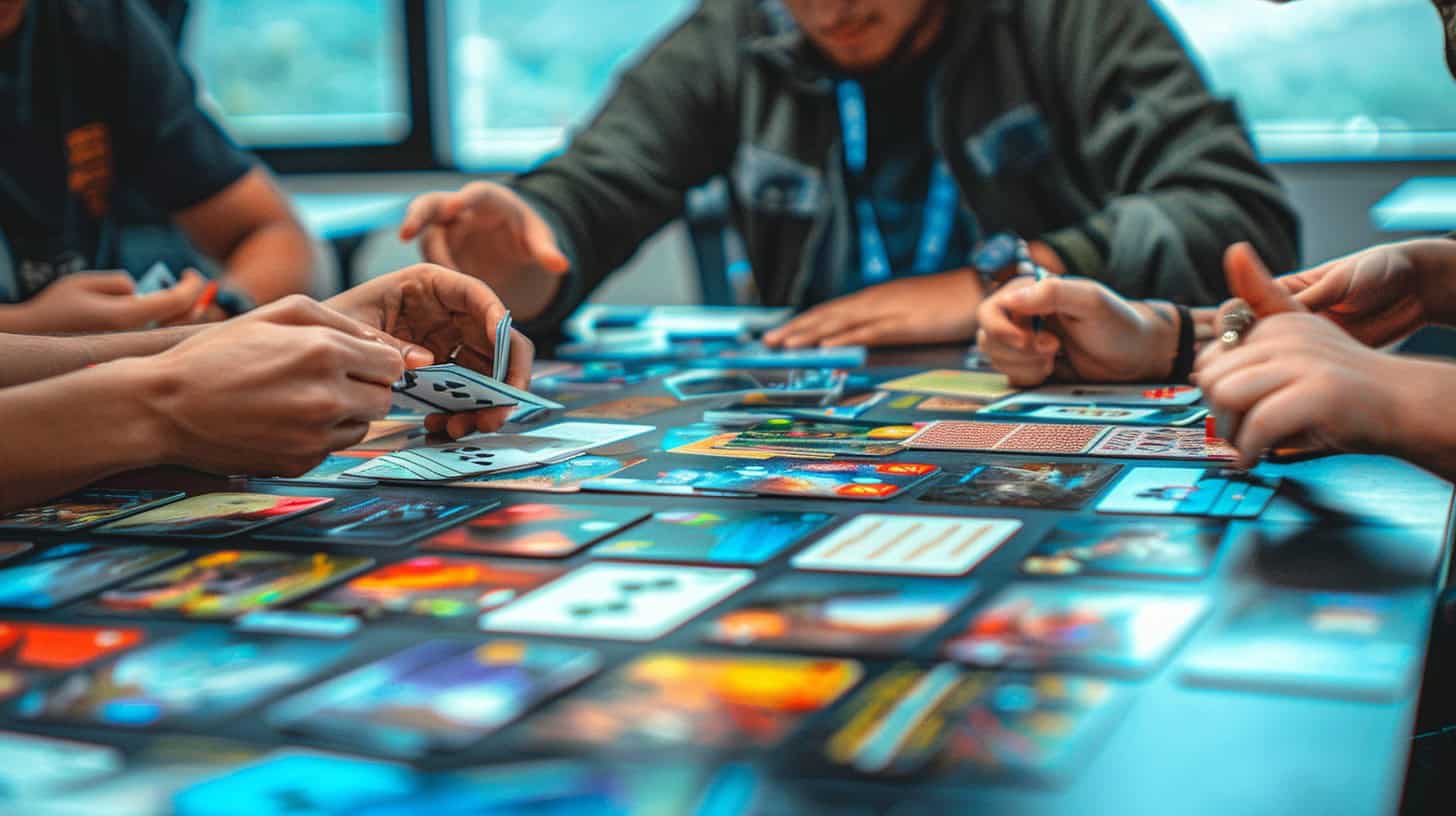
Making a card game takes more than just ideas; it needs careful planning and smart choices. Use drawing apps to design cards that stand out. Make sure the important parts of your cards pop.
Testing the game multiple times with friends and family is key. Their feedback will tell you if your game is fun or needs work. For changes, print new versions using high-quality printers for clear visuals.
Choose a reliable printer who understands card games for production. They should know about things like printing plates and web presses. Keep track of how many games you need to sell to break even—this number matters a lot.
Also, explore different types of games before settling on one style; this helps find what works best. Lastly, be ready to show off your game at different stages to catch a publisher’s eye—they can help make your game known to more people.
FAQs About How to Make Card Games
What’s the first step in making a card game?
Start with brainstorming! Think about your game’s plot, characters, and what makes it different. Creativity is key here.
How do I decide on my game’s rules?
Think about the gameplay experience you want. Use a decision tree to map out possibilities… then simplify. Remember, complexity isn’t always better.
Can I make cards that look professional at home?
Yes! A good card printer can work wonders. For that extra touch, consider gilt edges – they look amazing.
How important are storylines in card games?
Very! Great narratives turn simple play into meaningful learning and memorable experiences… They’re not just for video games!
What should I check before printing my game?
Do an inspection of your design specifications – think about size, text clarity, and image quality… And don’t forget to test with friends or family; feedback is gold.
